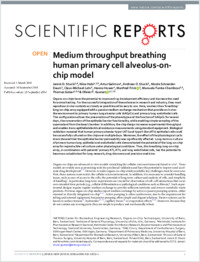Medium throughput breathing human primary cell alveolus-on-chip model.
- Stucki JD ARTORG Center for Biomedical Engineering Research, Organs-on-Chip Technologies, University of Bern, Bern, Switzerland.
- Hobi N ARTORG Center for Biomedical Engineering Research, Organs-on-Chip Technologies, University of Bern, Bern, Switzerland.
- Galimov A ARTORG Center for Biomedical Engineering Research, Organs-on-Chip Technologies, University of Bern, Bern, Switzerland.
- Stucki AO ARTORG Center for Biomedical Engineering Research, Organs-on-Chip Technologies, University of Bern, Bern, Switzerland.
- Schneider-Daum N Helmholtz Institute for Pharmaceutical Research Saarland, Helmholtz Center for Infection Research, Biopharmaceutics and Pharmaceutical Technology, Saarland University, Saarbrücken, Germany.
- Lehr CM Helmholtz Institute for Pharmaceutical Research Saarland, Helmholtz Center for Infection Research, Biopharmaceutics and Pharmaceutical Technology, Saarland University, Saarbrücken, Germany.
- Huwer H SHG Clinics, Department of Cardiothoracic Surgery, Völklingen Heart Center, Völklingen, Germany.
- Frick M Institute of General Physiology, University of Ulm, Ulm, Germany.
- Funke-Chambour M Department of Pulmonary Medicine, University Hospital of Bern, Bern, Switzerland.
- Geiser T Department of Pulmonary Medicine, University Hospital of Bern, Bern, Switzerland.
- Guenat OT ARTORG Center for Biomedical Engineering Research, Organs-on-Chip Technologies, University of Bern, Bern, Switzerland. olivier.guenat@artorg.unibe.ch.
- 2018-09-27
Published in:
- Scientific reports. - 2018
Epithelial Cells
Equipment Design
Humans
Pulmonary Alveoli
Reproducibility of Results
Respiration
Tissue Array Analysis
English
Organs-on-chips have the potential to improve drug development efficiency and decrease the need for animal testing. For the successful integration of these devices in research and industry, they must reproduce in vivo contexts as closely as possible and be easy to use. Here, we describe a 'breathing' lung-on-chip array equipped with a passive medium exchange mechanism that provide an in vivo-like environment to primary human lung alveolar cells (hAEpCs) and primary lung endothelial cells. This configuration allows the preservation of the phenotype and the function of hAEpCs for several days, the conservation of the epithelial barrier functionality, while enabling simple sampling of the supernatant from the basal chamber. In addition, the chip design increases experimental throughput and enables trans-epithelial electrical resistance measurements using standard equipment. Biological validation revealed that human primary alveolar type I (ATI) and type II-like (ATII) epithelial cells could be successfully cultured on the chip over multiple days. Moreover, the effect of the physiological cyclic strain showed that the epithelial barrier permeability was significantly affected. Long-term co-culture of primary human lung epithelial and endothelial cells demonstrated the potential of the lung-on-chip array for reproducible cell culture under physiological conditions. Thus, this breathing lung-on-chip array, in combination with patients' primary ATI, ATII, and lung endothelial cells, has the potential to become a valuable tool for lung research, drug discovery and precision medicine.
- Language
-
- English
- Open access status
- gold
- Identifiers
-
- DOI 10.1038/s41598-018-32523-x
- PMID 30254327
- Persistent URL
- https://folia.unifr.ch/global/documents/156957
Statistics
Document views: 10
File downloads:
- fulltext.pdf: 0
